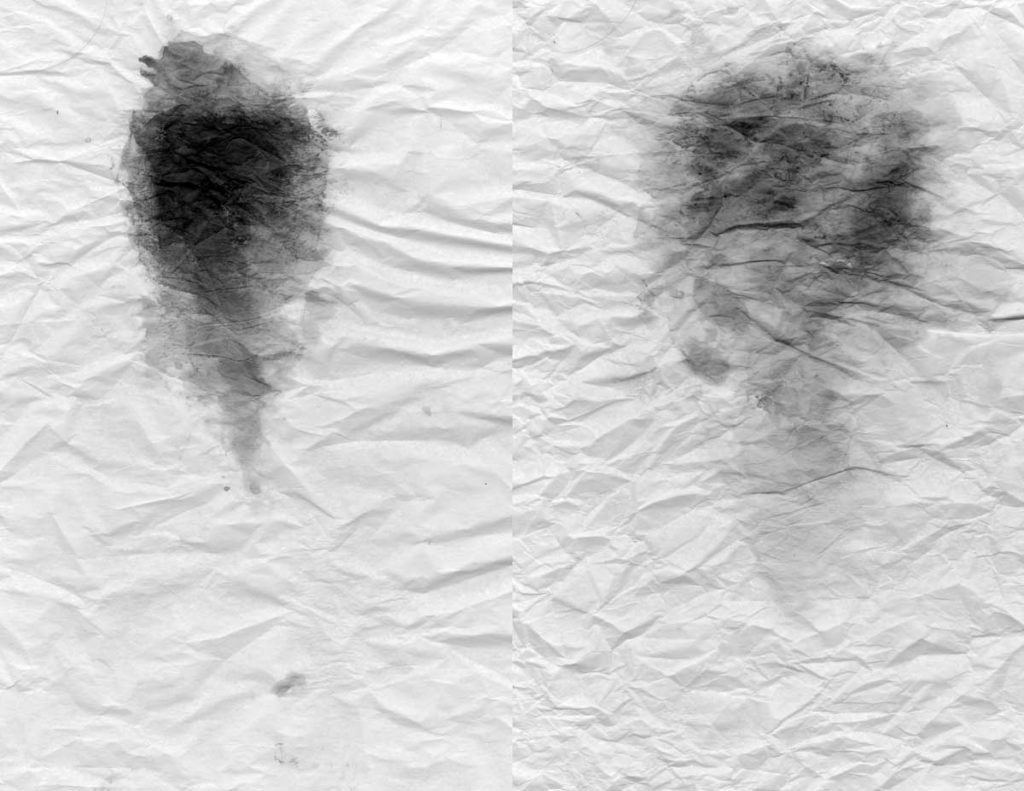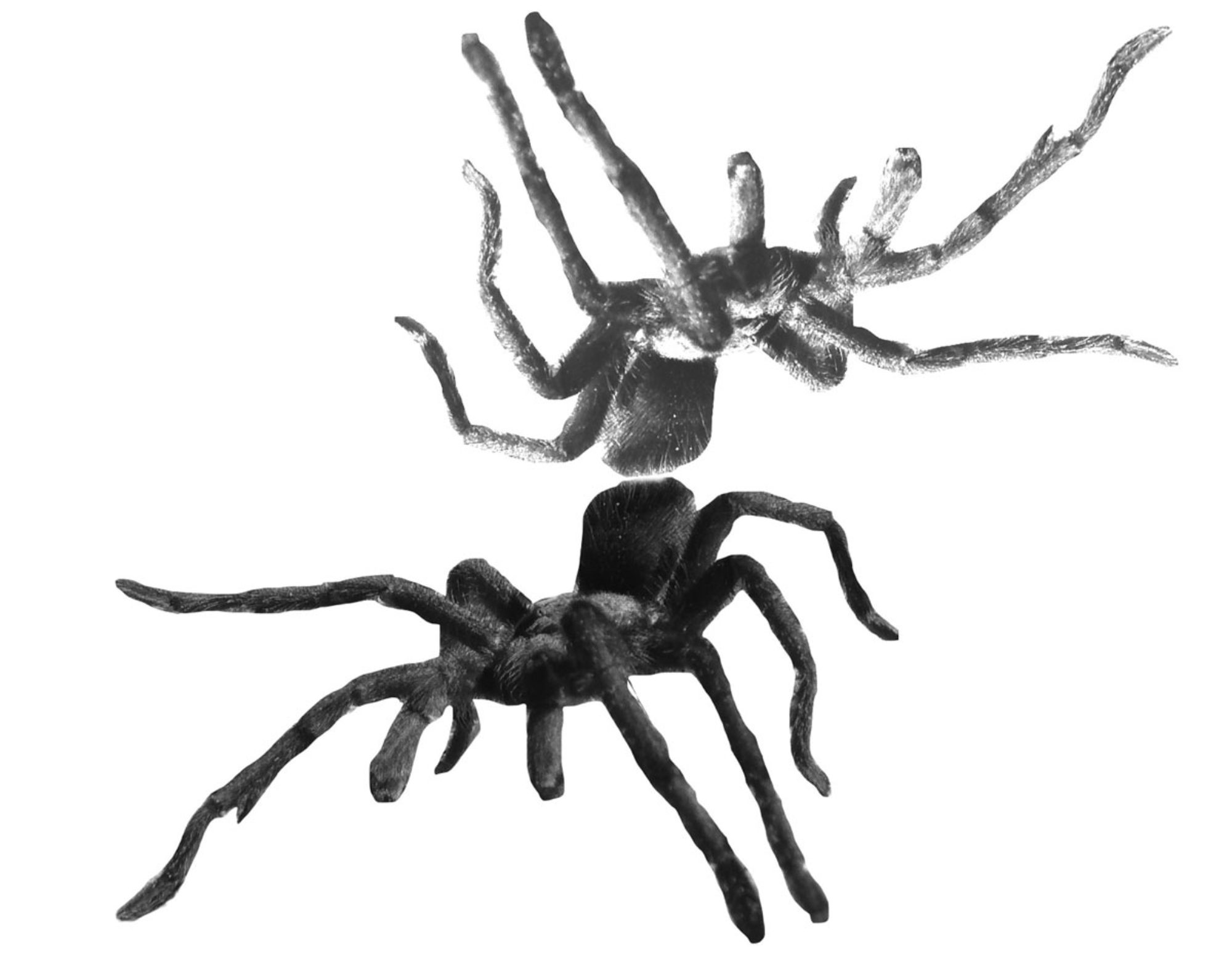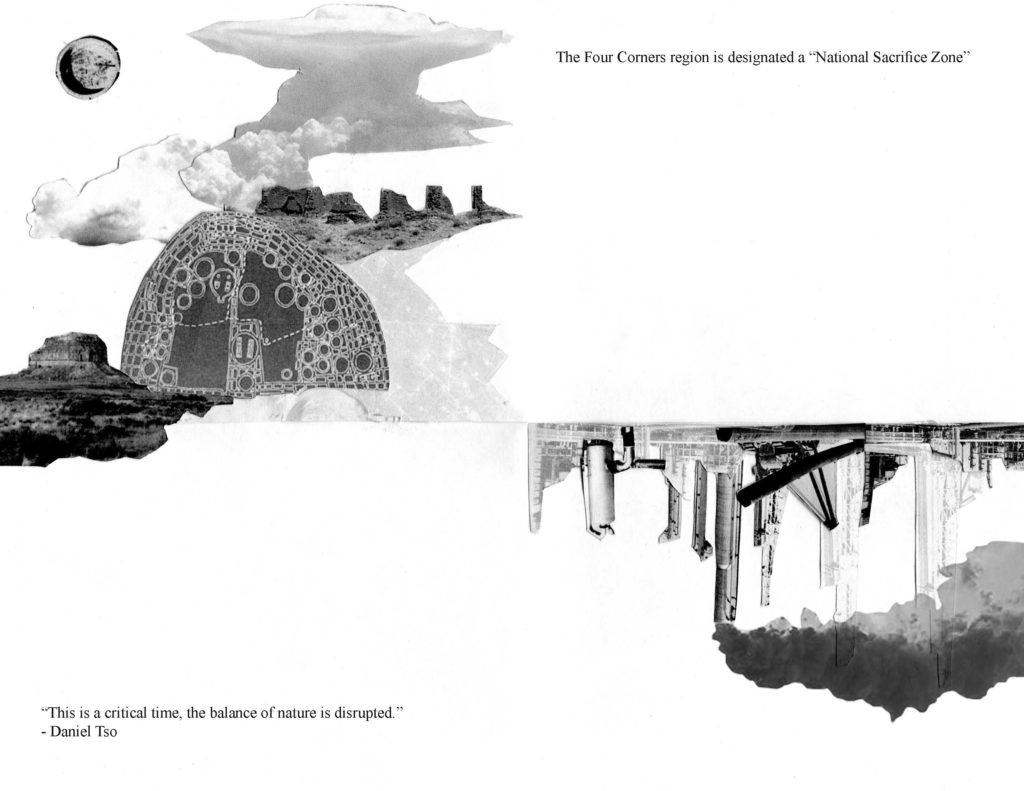
This censorship timeline was originally compiled as a creative research ‘flow/redaction chart’ in order to help us piece together what happened, when it happened, who was involved, what was left out, and to better understand how censorship occurs and how it is covered up. It was later published as A Censorship Timeline: Hey It’s Another State-sponsored Obfuscation in Cultural Real-Time in The Tool Book Project Volume III: Work Book.
Frustrated with feeling like the NM Department of Cultural Affairs and Museum of Art were not being honest with the information they provided us in an official statement, we decided to request Freedom of Information materials, known in New Mexico as Inspection of Public Records Act documents.
We submitted the IPRA request on July 15, 2019. We received the first group of documents on August 9 along with a letter telling us that another batch was on its way, although taking more time than anticipated due to the need “to review additional documents for exemption… and if necessary, redactions…” We received the last documents on August 21 and a letter noting that in regards to these documents attorney-client privileges have been waived in the interest of full disclosure. No redactions were evident.
The official IPRA documents handed over to us by the State of New Mexico were a jumbled and disordered chain of email communications between New Mexico Department of Cultural Affairs/ New Mexico Museum of Art employees, and Art Zine artists and project directors Jeanette Hart-mann and Asha Canalos. It took Hart-Mann and Canalos weeks to organize these into a coherent timeline of communications in order to decipher what the motives were for censoring the art zines and then reinstating them back into museum programming.
The following timeline and IPRA excerpts have been collated into chronological order. White font dates/text provide the date the email exchange occurred and a brief contextual description of what the email refers to and what happened. Red font text are emails we received from NMDCA/MOA. We include these timeline email exchanges because they were missing from the IPRA documents that were provided to us revealing that there is still undisclosed information about this censorship out there. The sections marked “Secret Interdepartment IPRA” are copies of the original IPRA pdfs supplied to us from DCA Legal Division.
This censorship timeline and dossier of IPRA documents was compiled by Jeanette Hart-Mann and Asha Canalos.
March 19, 2019
Rebecca Aubin, Head of Education and Visitor Experience at The New Mexico Museum of Art (NMMOA), leaves a comment on the art zine web page:
“We would like to use one of your zines for an upcoming exhibition at the New Mexico Museum of Art: Social & Sublime: Land, Place, Art “
March 20, 2019
Art zine artist, Asha Canalos contacts Aubin via email, cc’ing artists Jeanette Hart-Mann and Ryan Henel. Hart-Mann responds to email with interest and request for more information.
Aubin emails Canalos and Hart-Mann with additional information and cc’s Christian Waguespak, NMMOA Curator of 20th Century Art.
LAAW artists and project collaborators all agree to being involved in the exhibition.
March 25, 2019
Aubin informs Canalos and Hart-Mann that the museum would ideally like 1,000 copies of ‘Imbalance’ for the exhibition, and that she will look into how many the museum can budget toward printing costs.
March 26, 2019
Aubin lets Canalos and Hart-Mann know that the museum cut the budget for ‘Social & Sublime: Land, Place & Art,’ and cannot fund zine printing but asks if the artists can raise funds to print.
March 27, 2019
The funding goal is met and exceeded by contributions from coalition partners, LAAW, Diné CARE, Tewa Women United, and a private party.
March 28, 2019
Hart-Mann sends label information to Aubin to include in the exhibition and requests exhibition PR announcements to share with artists and partners. With the combined funds, 1,162 zines are printed at UNM for the exhibit.
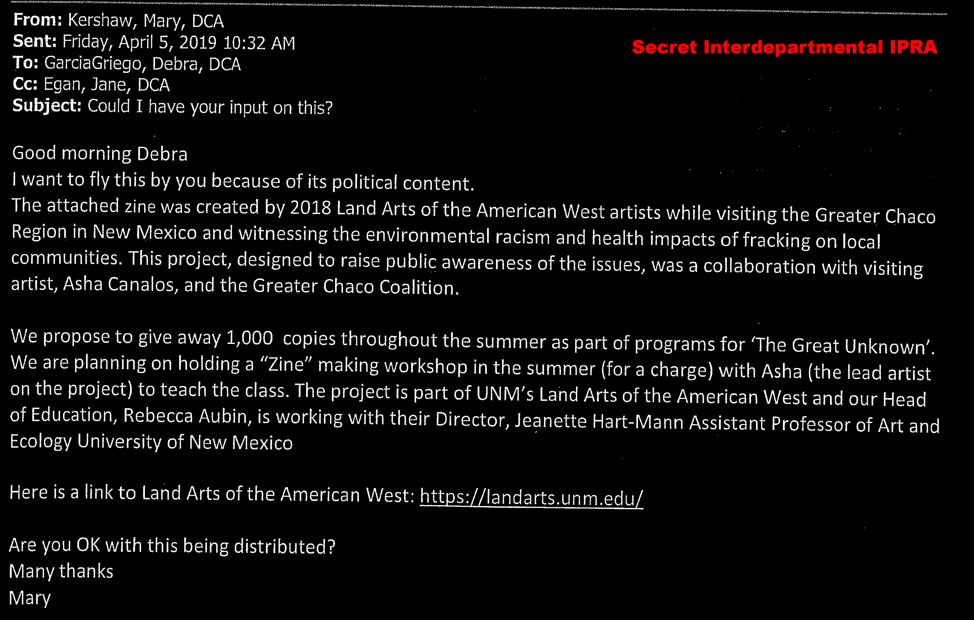
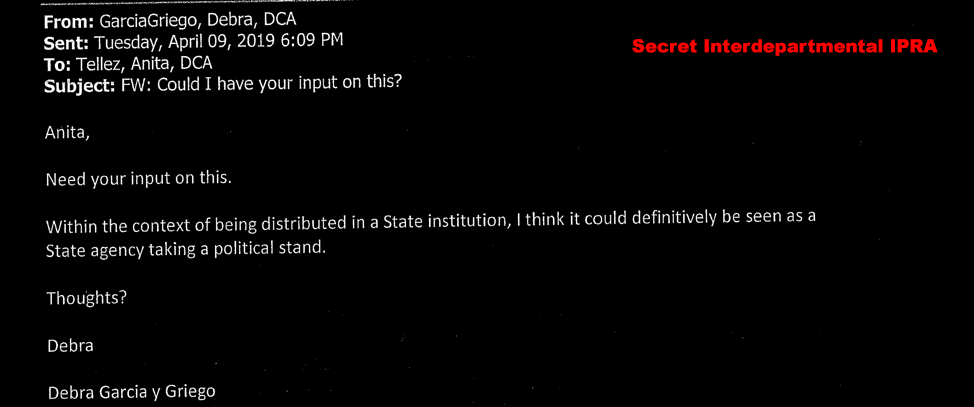
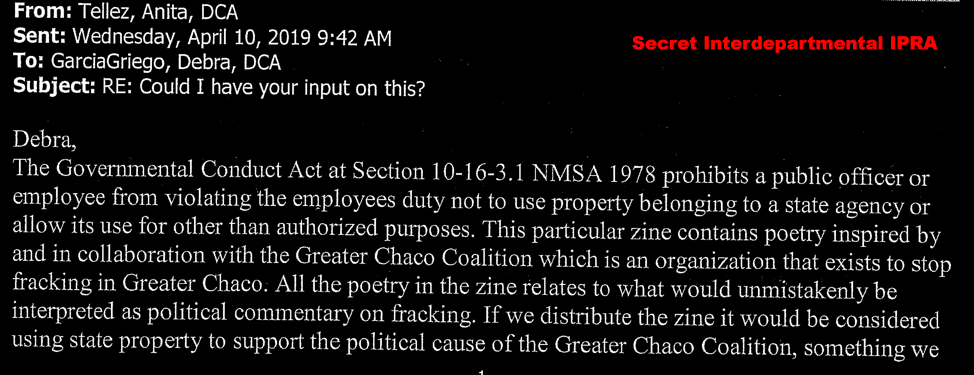

April 11, 2019
Canalos requests further info regarding delivery to the museum.
NMMOA Curator of 20th Century Art, Waguespak, responds:
“So good to hear from you. I will go speak with Rebecca Aubin and get back with you as soon as I can. I’m so excited to have these as part of the exhibition! Thank you so much for helping make this possible. “

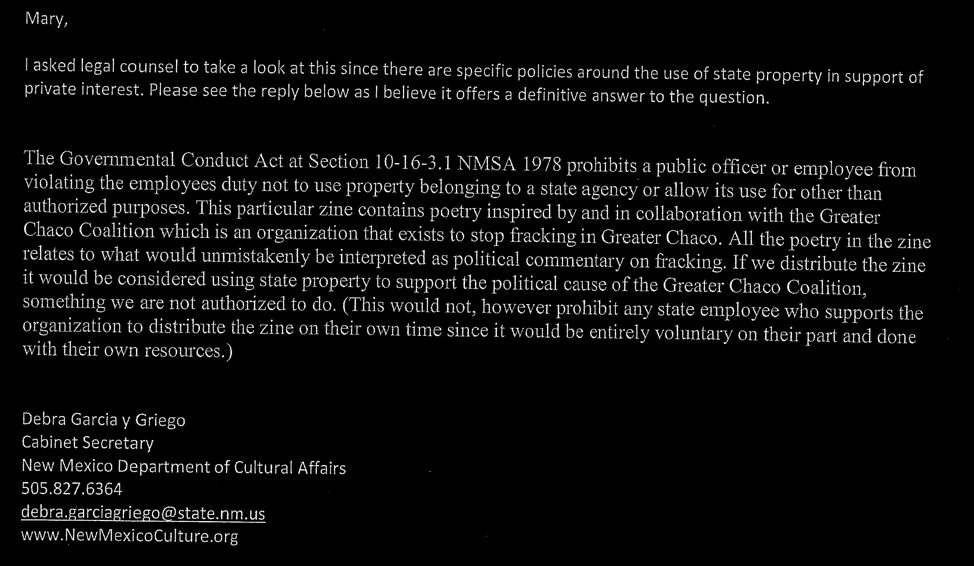
April 12, 2019
Canalos delivers 1,162 ‘Imbalance’ art zines to NMMOA in Santa Fe, New Mexico.

April 13, 2019
Social & Sublime: Land, Place and Art exhibition opens at NMMOA.
May 15, 2019
UNM Department of Art receives a phone call from a man in Santa Fe who found several boxes of publications titled ‘Imbalance’ on a utility box next to his mailbox on the street. He says that the boxes were sitting there for several days before he opened them up and discovered the zines inside. Hart-Mann is contacted regarding the situation since ‘Land Arts of the American West’ is on the cover. Hart-Mann notifies Canalos about the issue.
Hart-Mann emails and calls Aubin to ask about the zines, but gets no answer, and leaves a message.
May 16,2019
Hart-Mann meets the man who found the zines and picks these up from him. She then visits the NMMOA exhibition, ‘Social & Sublime: Land, Place and Art’ and cannot locate the zines in the exhibition. She attempts to meet with Aubin, but Aubin is unavailable and out giving school tours.
May 22, 2019
Hart-Mann and Canalos write the following email to Aubin:
“In order to inform all artists and partners involved in the fundraising and creation of the Greater Chaco Art Zine, ‘Imbalance,’ we are requesting an official statement from the New Mexico Museum of Art stating why this art zine was removed from the exhibition, ‘Social & Sublime: Land, Place, and Art. Can you please share this request with the appropriate official who can provide us with this statement? Also, we would like to request that the remainder of the art zines be properly stored by the museum until we can pick them up… “
Aubin confirms that she will relay the request and store the remaining zines.
May 23, 2019
Canalos and Hart-Mann inform collaborating partners and partner organizations in the Greater Chaco Coalition about the removal of the Chaco Art Zine from the NMMOA, and without using Aubin’s name, relay the content of the whistle-blown internal email issued by New Mexico Department of Cultural Affairs (NMDCA) Cabinet Secretary, Garcia y Griego.

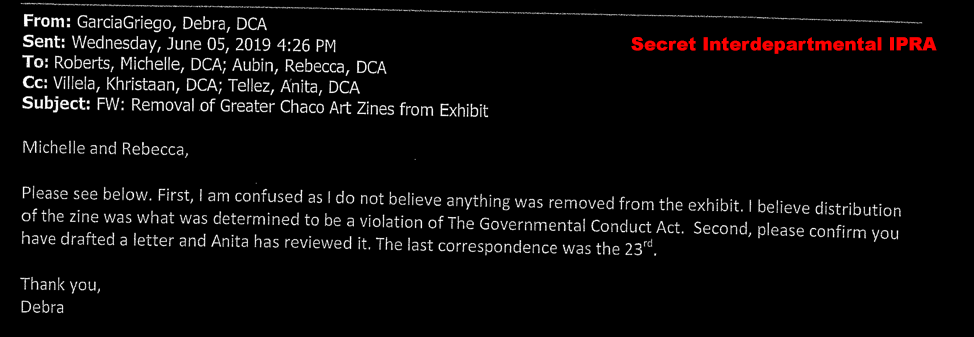
June 6, 2019
Hart-Mann, Canalos, and LAAW artists send a letter to Garcia y Griego and NMDCA lawyer, Jane Egan asking for an explanation as to why the zines were removed from the museum and requesting their reinstatement.
Garcia y Griego responds:
“Thank you for bringing your concerns to me and for following up directly. My department is gathering information for a response. Please stand by. ”
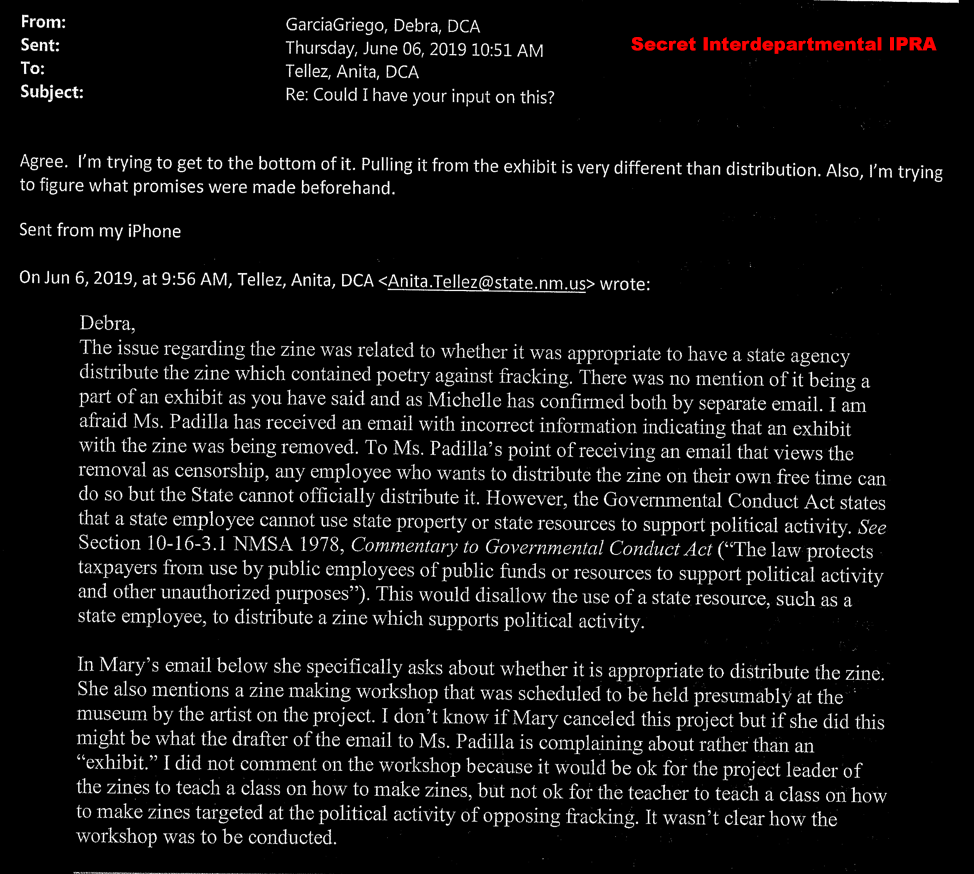

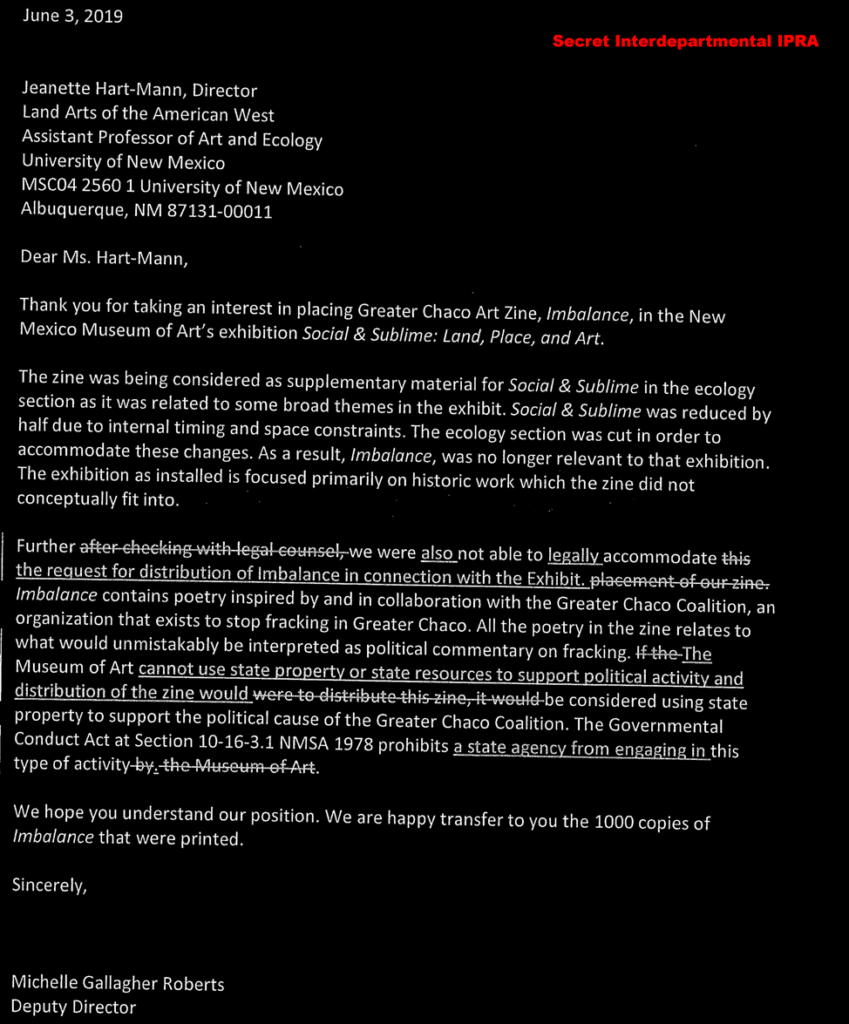


June 12, 2019
The new acting Director of NMMOA, Michelle Roberts, emails Hart-Mann with the “official” NMMOA response:
Dear Ms. Hart-Mann,
Thank you for your interest in placing the Greater Chaco Art Zine, Imbalance, in the New Mexico Museum of Art’s exhibition Social & Sublime: Land, Place, and Art.
Originally, the zine was being considered as supplementary material for the education table in the ecology section of Social & Sublime as it was related to themes in the exhibit. The inclusion of this zine in the resource center would have also intersected with themes from another exhibit on display at the same time, The Great Unknown: Artists at Glen Canyon and Lake Powell. In March, Social & Sublime was reduced by half due to internal timing and space constraints. The ecology section was cut in order to accommodate these changes. As a result, Imbalance, was no longer relevant to Social & Sublime. The exhibition, as it is currently installed, is focused primarily on historic work which the zine did not conceptually fit into.
A slight internal miscommunication primarily regarding the context and the manner of presentation of the zine led to the recommendation to restrict distribution of the zine. We apologize for this error and regret that our planning process was not adequately conveyed to you.
We wish to inform you that this summer, we are planning on hosting a zine workshop so museum visitors can create their own zines on topics of their choice. In connection with the workshop, Imbalance will be made available as an example to participants. We will also make Imbalance available in the resource center for the exhibit The Great Unknown.
Sincerely,
Michelle
June 21, 2019
Aubin emails Canalos to re-invite her to teach a zine workshop at the museum.
June 28, 2019
Hart-Mann and Canalos again discuss the situation with coalition partners and LAAW artists.
Aubin confirms via email to Canalos that she believes the removal of the zines to be an act of censorship and not, as stated by other NMDCA representatives, due to a programmatic change that made the zines less contextually applicable. She also reveals that she was disciplined for her advocacy of the zine. Additionally, Aubin states that she is no longer permitted to speak with Hart-Mann.
Canalos alerts Aubin that, out of respect to the partners in the zine project and because of the censorship issue, she will not be able to lead a workshop at the museum.
July 1, 2019
Canalos speaks with Aubin directly on a private line.
Aubin describes the censorship of the zines, including the order being issued from Garcia y Griego. Aubin says she is willing to go on the record with her account of what happened.

July 15, 2019
Canalos and Hart-Mann send, via certified mail, a request to see NMDCA’s internal correspondence regarding the Greater Chaco Art Zines, under The New Mexico Inspection of Public Records Act, 14-2-1 NMSA 1978 (IPRA).
July – August, 2019
A censorship timeline of the Greater Chaco Art Zines is compiled by Jeanette Hart-Mann and Asha Canalos. As their primary document of record before they received the requested IPRA documents, it is a reflection of the information Hart-Mann and Canalos gathered during this process while they grappled with the issue of censorship and tried to piece together what was really happening. This was published in October, 2019 as a visual artwork titled, A Censorship Timeline: Hey It’s Another State-Sponsored Obfuscation in Cultural Real-Time, in “The Tool Book Project Volume III: Work Book.”
August – December, 2019
Canalos and Hart-Mann receive, organize, and collate IPRA documents into a dossier and share all information with project artists and coalition partners. Everyone agrees that this issue needs to be made public. Hart-Mann and Canalos develop and publish a website, greaterchacoartzines.org, presenting the art zines and all censorship documents. They also create an online petition demanding that the New Mexico Department of Cultural Affairs and Museum of Art reevaluate, clarify, and state their position as a public institution on works of art addressing extraction’s impacts on local communities, ecologies, and climate.
January 2020
Hart-Mann and Canalos launch ‘Chronicle of Disappeared Arts (CODA)’ a project dedicated to supporting dialogue around issues of censorship and artworks which counter systemic oppression and environmental injustice.
February 11, 2020
Investigative Journalist, Elizabeth Miller, emails to say that she has a possible news outlet interested in publishing her story about the censorship issue. In the same email she suggests that we contact the National Coalition Against Censorship (NCAC).
March 9, 2020
Canalos and Hart-Mann meet with NCAC Director of Programs, Svetlana Mintcheva and discuss the censorship issue.
March 12 2020. Canalos and Hart-Mann, drawing on advice from the NCAC, modify the petition language to explicitly request that the New Mexico Museum of Art adopts clear policy affirming artistic.
March 16 2020. The National Coalition Against Censorship issues a letter to the New Mexico Museum of Art and The New Mexico Department of Cultural Affairs, offering to assist in crafting new policy to affirm artistic freedom.
March 20 2020. The New Mexico Museum of Art responds to the NCAC’s letter and rejects NCAC’s suggestion of working together to build policies affirming artistic freedom.
March 31 2020. Hart-Mann and Canalos, along with NCAC, send letters to Michelle Roberts, NMMoA and NMDCA summarizing the results of the IPRA request, alerting them to the website and petition, and once again asking them to create a clear policy affirming artistic freedom. No response is ever received.
